Message From Our President

Dear Students, Faculty, Staff and Friends,
I am pleased to present to you this Guide to our plans for the upcoming fall semester and reopening of our campuses. In form and in content, this coming semester will be like no other. We will live differently, work differently and learn differently. But in its very difference rests its enormous power.
The mission of Yeshiva University is to enrich the moral, intellectual and spiritual development of each of our students, empowering them with the knowledge and abilities to become people of impact and leaders of tomorrow. Next year’s studies will be especially instrumental in shaping the course of our students’ lives. Character is formed and developed in times of deep adversity. This is the kind of teachable moment that Yeshiva University was made for. As such, we have developed an educational plan for next year that features a high-quality student experience and prioritizes personal growth during this Coronavirus era. Our students will be able to work through the difficulties, issues and opportunities posed by our COVID-19 era with our stellar rabbis and faculty, as well as their close friends and peers at Yeshiva.
To develop our plans for the fall, we have convened a Scenario Planning Task Force made up of representatives across the major areas of our campus. Their planning has been guided by the latest medical information, government directives, direct input from our rabbis, faculty and students, and best practices from industry and university leaders across the country. I am deeply thankful to our task force members and all who supported them for their tireless work in addressing the myriad details involved in bringing students back to campus and restarting our educational enterprise.
In concert with the recommendations from our task force, I am announcing today that our fall semester will reflect a hybrid model. It will allow many students to return in a careful way by incorporating online and virtual learning with on-campus classroom instruction. It also enables students who prefer to not be on campus to have a rich student experience by continuing their studies online and benefitting from a full range of online student services and extracurricular programs.
In bringing our students back to campus, safety is our first priority. Many aspects of campus life will change for this coming semester. Gatherings will be limited, larger courses will move completely online. Throughout campus everyone will need to adhere to our medical guidelines, including social distancing, wearing facemasks, and our testing and contact tracing policies. Due to our focus on minimizing risk, our undergraduate students will begin the first few weeks of the fall semester online and move onto the campus after the Jewish holidays. This schedule will limit the amount of back and forth travel for our students by concentrating the on-campus component of the fall semester to one consecutive segment.
Throughout our planning, we have used the analogy of a dimmer switch. Reopening our campuses will not be a simple binary, like an on/off light switch, but more like a dimmer in which we have the flexibility to scale backwards and forwards to properly respond as the health situation evolves. It is very possible that some plans could change, depending upon the progression of the virus and/or applicable state and local government guidance.
Before our semester begins, we will provide more updates reflecting our most current guidance. Please check our website, yu.edu/fall2020 for regular updates. We understand that even after reading through this guide, you might have many additional questions, so we will be posting an extensive FAQ section online as well. Additionally, we will also be holding community calls for faculty, students, staff and parents over the next couple of months.
Planning for the future during this moment has certainly been humbling. This Coronavirus has reminded us time and time again of the lessons from our Jewish tradition that we are not in full control of our circumstances. But our tradition also teaches us that we are in control of our response to our circumstances. Next semester will present significant challenges and changes. There will be some compromises and minor inconveniences--not every issue has a perfect solution. But faith and fortitude, mutual cooperation and resilience are essential life lessons that are accentuated during this period. And if we all commit to respond with graciousness, kindness, and love, we can transform new campus realities into profound life lessons for our future.
Deeply rooted in our Jewish values and forward focused in preparing for the careers and competencies of the future, we journey together with you, our Yeshiva University community, through these uncharted waters. Next year will be a formative year in the lives of our students, and together we will rise to the moment so that our students will emerge stronger and better prepared to be leaders of the world of tomorrow.
Best Wishes,
Ari Berman


 The past of the Jewish book is long and complex. We have to go back to tablets, then to a long history of scrolls, first papyrus and then parchment. The introduction of the codex changed little at first, and for sacred use, has still changed nothing at all.
But for Jewish books of study, the codex emerged as the form of choice by the Middle Ages. It has, as historian Robert Darnton has written, “proven to be a marvelous machine—great for packaging information, convenient to thumb through, comfortable to curl up with, superb for storage, and remarkably resistant to damage.” (1) When one looks closer, a very particular form of the book—more precisely, of the page of the book—has emerged in the past millennium that reflects, and in turn animates, Jewish learning and mentality.
The quintessential Jewish book is the mikra’ot gedolot: each page displays a central text, in this case the Bible, with commentaries, always in dialogue with each other, surrounding it. The page is thus highly self-referential: one paragraph on the page disputes another paragraph a few inches away, and both are discussing the text in the center. The same form is emulated also in the traditional Talmud, the standard printings of Maimonides’ code of law, and even the authoritative law code, R. Joseph Karo’s Shulchan Arukh. No text—even as centrally canonical a text as the Torah itself or the authoritative code of Jewish law—is ever allowed to stand alone; the “table” without the “tablecloth” would be bare. It also would not be universally Jewish, because the dialogue and give-and-take is what allows, for example, Ashkenazim and Sepharadim to share the same book of Jewish law.
Jewish texts are fundamentally about the point and the counterpoint encountered simultaneously. Perhaps this is even more deeply embedded in Jewish learning, going back to the “pairs” of Second Temple Sages, the Houses of Hillel and Shammai, and the ever-contending Talmudic colleagues Rav and Samuel, Rabbi Yoḥanan and Resh Laqish, Abbaye and Rava, and numerous others. Graphically, this takes a new turn with the printings of Rashi and Tosafot, the Rambam and the Raavad, and so on. Now the page confronts the reader—better, the learner—with dispute, dialogue and dilemma before one has even begun. The first thing one knows is that there is no consensus on this page but rather an eternal dynamism and continuous hyperlinking, fostering creativity and active engagement, with each text opening up other texts.
The future of the Jewish book will take two complementary forms, both already seen in sites now changing the face of Jewish learning. On the one hand, we have the model of Sefaria (
The past of the Jewish book is long and complex. We have to go back to tablets, then to a long history of scrolls, first papyrus and then parchment. The introduction of the codex changed little at first, and for sacred use, has still changed nothing at all.
But for Jewish books of study, the codex emerged as the form of choice by the Middle Ages. It has, as historian Robert Darnton has written, “proven to be a marvelous machine—great for packaging information, convenient to thumb through, comfortable to curl up with, superb for storage, and remarkably resistant to damage.” (1) When one looks closer, a very particular form of the book—more precisely, of the page of the book—has emerged in the past millennium that reflects, and in turn animates, Jewish learning and mentality.
The quintessential Jewish book is the mikra’ot gedolot: each page displays a central text, in this case the Bible, with commentaries, always in dialogue with each other, surrounding it. The page is thus highly self-referential: one paragraph on the page disputes another paragraph a few inches away, and both are discussing the text in the center. The same form is emulated also in the traditional Talmud, the standard printings of Maimonides’ code of law, and even the authoritative law code, R. Joseph Karo’s Shulchan Arukh. No text—even as centrally canonical a text as the Torah itself or the authoritative code of Jewish law—is ever allowed to stand alone; the “table” without the “tablecloth” would be bare. It also would not be universally Jewish, because the dialogue and give-and-take is what allows, for example, Ashkenazim and Sepharadim to share the same book of Jewish law.
Jewish texts are fundamentally about the point and the counterpoint encountered simultaneously. Perhaps this is even more deeply embedded in Jewish learning, going back to the “pairs” of Second Temple Sages, the Houses of Hillel and Shammai, and the ever-contending Talmudic colleagues Rav and Samuel, Rabbi Yoḥanan and Resh Laqish, Abbaye and Rava, and numerous others. Graphically, this takes a new turn with the printings of Rashi and Tosafot, the Rambam and the Raavad, and so on. Now the page confronts the reader—better, the learner—with dispute, dialogue and dilemma before one has even begun. The first thing one knows is that there is no consensus on this page but rather an eternal dynamism and continuous hyperlinking, fostering creativity and active engagement, with each text opening up other texts.
The future of the Jewish book will take two complementary forms, both already seen in sites now changing the face of Jewish learning. On the one hand, we have the model of Sefaria (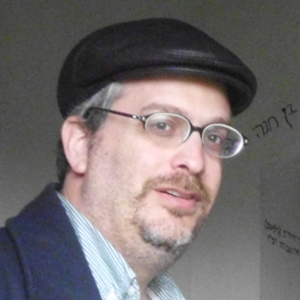 Rabbi Elli Fischer
Rabbi Elli Fischer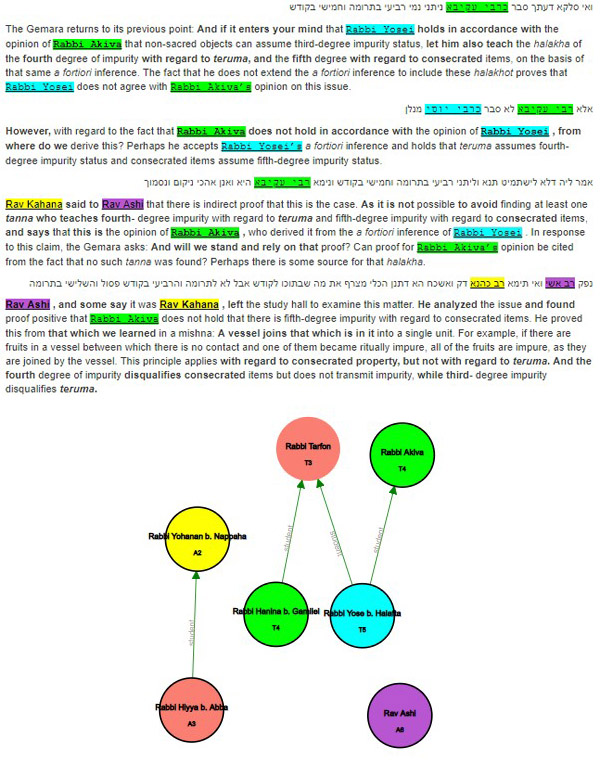 Marked-up text and Graph from Pesachim 19a
Marked-up text and Graph from Pesachim 19a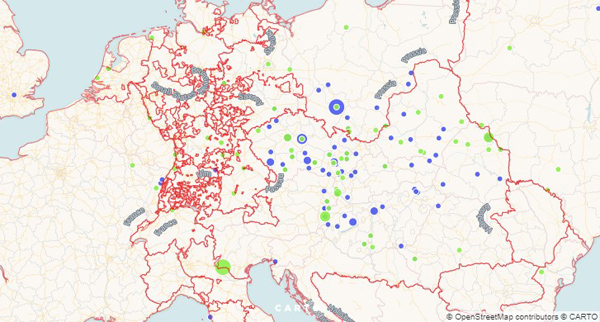 Responsa Noda BiYehuda vol. 1 (green) and vol. 2 (blue)
Responsa Noda BiYehuda vol. 1 (green) and vol. 2 (blue) “Heat map” of Responsa Maharsham, by province
“Heat map” of Responsa Maharsham, by province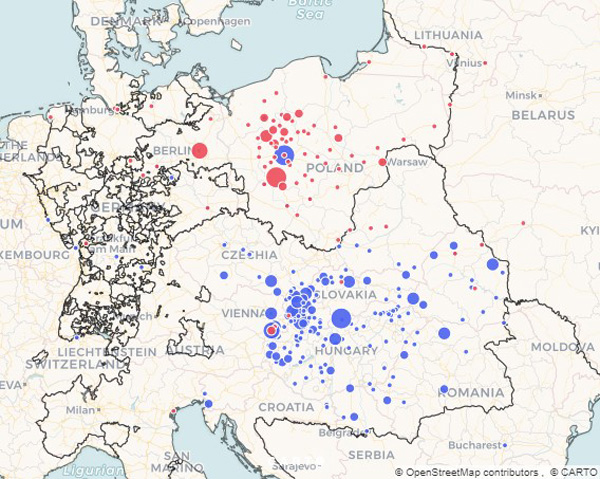 Geographical reach of Responsa Hatam Sofer (blue) and Responsa Rabbi Akiva Eger (red)
Geographical reach of Responsa Hatam Sofer (blue) and Responsa Rabbi Akiva Eger (red)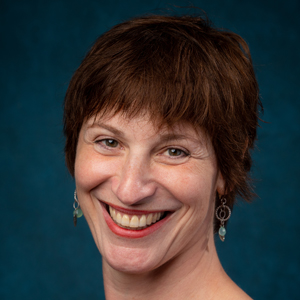 What is the worth of the novel in a world that revolves ever more around screens? This question lies at the heart of several courses I teach. One way to address it is to think about the qualities that belong to the novel: what is it, if anything, that makes the novel unique?
While the answers are various, mine has to do with the novel’s manipulation of the reader’s perspective. In the mid-1700s, when the novel began to be recognized as a distinct literary form, the quality that set it apart was its commitment to “formal realism,” a term coined by Ian Watt in The Rise of the Novel to describe the idea “that the novel is a full and authentic report of human experience” (32). Instead of classical models, novels took their inspiration from contemporary life. Their settings were concrete, specific and recognizable and their characters individuals instead of representative types. Films, of course, do this as well.
Novels, however, have the capacity to place the reader’s perspective inside the protagonist’s head. Passages that do so create the illusion that the reader has direct and unmediated access to the protagonist’s private thoughts and emotions. For a moment, the perspective of the character and the reader are close, if not one and the same. Frequently, these passages ask readers to register the difference between a character’s private, internal experience and the way that character appears in that particular scene. Film cannot invite viewers to experience this sense of “inside” and “outside” in quite the same way because it conveys all information through external signs.
This difference is evident if we compare a scene from the 1995 film adaptation of Jane Austen’s Persuasion (1818) with the original scene in the novel. In the film adaptation, the heroine, Anne Elliot, unexpectedly encounters her former fiancé, Captain Wentworth, while breakfasting with her sister, Mary. The sequence begins with short shots that convey the sudden, abrupt nature of the encounter. The camera zooms in on Anne’s face. . .
What is the worth of the novel in a world that revolves ever more around screens? This question lies at the heart of several courses I teach. One way to address it is to think about the qualities that belong to the novel: what is it, if anything, that makes the novel unique?
While the answers are various, mine has to do with the novel’s manipulation of the reader’s perspective. In the mid-1700s, when the novel began to be recognized as a distinct literary form, the quality that set it apart was its commitment to “formal realism,” a term coined by Ian Watt in The Rise of the Novel to describe the idea “that the novel is a full and authentic report of human experience” (32). Instead of classical models, novels took their inspiration from contemporary life. Their settings were concrete, specific and recognizable and their characters individuals instead of representative types. Films, of course, do this as well.
Novels, however, have the capacity to place the reader’s perspective inside the protagonist’s head. Passages that do so create the illusion that the reader has direct and unmediated access to the protagonist’s private thoughts and emotions. For a moment, the perspective of the character and the reader are close, if not one and the same. Frequently, these passages ask readers to register the difference between a character’s private, internal experience and the way that character appears in that particular scene. Film cannot invite viewers to experience this sense of “inside” and “outside” in quite the same way because it conveys all information through external signs.
This difference is evident if we compare a scene from the 1995 film adaptation of Jane Austen’s Persuasion (1818) with the original scene in the novel. In the film adaptation, the heroine, Anne Elliot, unexpectedly encounters her former fiancé, Captain Wentworth, while breakfasting with her sister, Mary. The sequence begins with short shots that convey the sudden, abrupt nature of the encounter. The camera zooms in on Anne’s face. . .
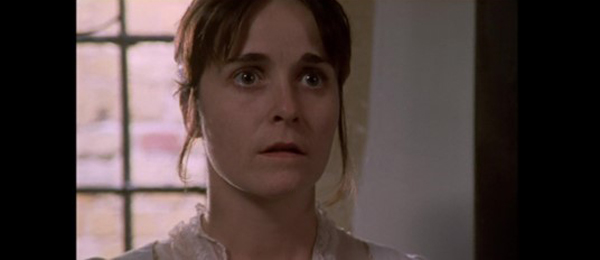 . . .before it pulls back to her standing beside Mary who is speaking to Wentworth.
. . .before it pulls back to her standing beside Mary who is speaking to Wentworth.
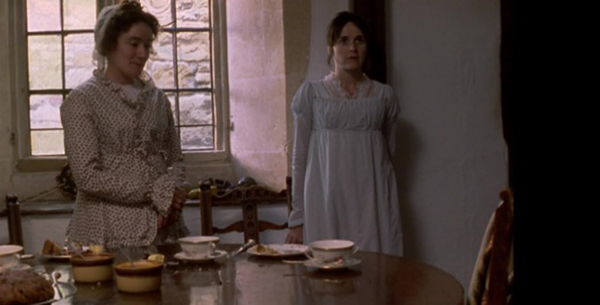 Finally, it gives us an extremely tight shot of Anne’s hand slowly tightening its grip on a chair.
Finally, it gives us an extremely tight shot of Anne’s hand slowly tightening its grip on a chair.
 This is a powerful sequence, one that signals Anne’s distress despite her wooden demeanor.
In the novel, however, Anne’s inner turmoil is much more immediate. Austen achieves this effect through “free indirect discourse,” a literary technique that creates the illusion that we are somehow inside a character’s head.* In the following passage, the shift to free indirect discourse makes Anne’s confusion—her inability to do anything but feel her emotions—perfectly clear.
This is a powerful sequence, one that signals Anne’s distress despite her wooden demeanor.
In the novel, however, Anne’s inner turmoil is much more immediate. Austen achieves this effect through “free indirect discourse,” a literary technique that creates the illusion that we are somehow inside a character’s head.* In the following passage, the shift to free indirect discourse makes Anne’s confusion—her inability to do anything but feel her emotions—perfectly clear.
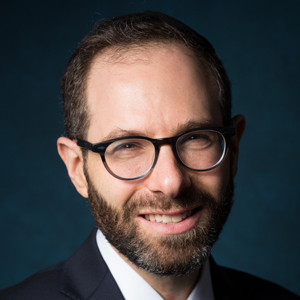 In recent years, one of the most impactful additions to the Talmudic library has been the Mesivta edition of the Talmud. The Mesivta Talmud provides the most thorough and annotated Hebrew translation of the Talmud to date, complete with diagrams and charts as well as a line-by-line explanation of every comment of Rashi and every observation of Tosfos.
Surprisingly, this is in fact the Mesivta Talmud’s least appreciated and significant contribution. The real innovation of the Mesivta Talmud is a topically arranged synopsis of every one of the classical commentaries from the medieval period through current day roshei yeshiva [professors of the yeshiva]. This is augmented by a section of longer essays which explore and summarize the larger and deeper topics and all of their permutations and ramifications. Just for good measure, the Mesivta Talmud also includes an expanded list of the halachic [Jewish law] decisions and homiletic elucidations culled from and concerning each respective page of the Talmud.
Even in the era of the internet, where we have instant and unfettered access to all kinds of literature and have become accustomed to an incessant onslaught of information, the Mesivta Talmud is truly a groundbreaking, thoughtful and organized reference, worthy of recognition and deserving of a prominent place in every beit midrash [study hall].
Nonetheless, if the objective of Talmud study is to emerge with a conceptual and pragmatic conclusion regarding the range of acceptable opinions, we must consider the proper function of the Mesivta Talmud. Simply put, will continued exposure to the diverse assortment of approaches and positions presented by the Mesivta Talmud enhance clarity and dispel confusion or will it, more often than not, produce a disoriented and muddled mayhem of convoluted Talmudic discourse? How can the Talmud student utilize and navigate this valuable resource while retaining some measure of pace, direction, and purpose?
For this reason, despite the plethora and panoply of information available at our fingertips, or perhaps precisely because of it, now more than ever, there is a dire need for the discerning guidance of an experienced teacher and mentor. I often encounter students who would like to “know how to learn” Talmud without much of a grasp for what that means or looks like. In its most basic iteration, one who “knows how to learn” Talmud, refers to one who has been trained how to identify and marginalize tangential or peripheral questions and details while consistently zeroing in on the core and fundamental themes of each Talmudic issue. Therefore, Rabbi Joseph B. Soloveitchik once compared the process of learning Talmud to identifying and taming a looming elephant while disregarding the flies buzzing overhead. Similarly, Rabbi Chaim Soloveitchik once remarked that the primary responsibility of a Talmud teacher is not to present new information and ingenious explanations but to dismiss and filter out mistaken ideas and impressions.
In endeavoring to use the Mesivta Talmud productively, one must be knowledgeable and experienced enough to scan for salient sources in order to identify the diamonds in the proverbial rough. More often than not, this process demands the courage and competence to carefully exclude fringe material. Undoubtably, this too is part of the mitzvah [obligation] of learning Torah. The tanna [Jewish sage] Shimon Ha’amsuni had a unique methodology of deriving halachos [laws] from the words of the Torah. However, after deliberately ploughing his way through four of the five books of the Torah, he encountered what appeared to be an insurmountable challenge to his operating premise. At which point, he unabashedly proclaimed, “Just as I have received reward for proposing the derivations, I will also receive reward for eliminating them” (Pesachim 22b). Rabbi Avraham, the son of the Rambam, extrapolates from the statement of Shimon Ha’amsuni that the mitzvah of Talmud Torah entails not only introducing new and innovative explanations of the Torah but also expelling that which is mistaken.
Rabbi Avraham Pam once shared that before presenting material to students, he would not only review the subject matter he had planned to discuss but would also regularly edit out items he decided not to examine. He subsequently reflected that the latter was much more valuable than the former.
Students as well must be trained not only to collect sources and perform independent analysis but also to quickly recognize the crux of an issue while simultaneously cultivating the bravery and sensitivity to weed out extraneous sources and complications. Indeed, this will increasingly become an indispensable tool for learning Torah successfully in the information age.
In recent years, one of the most impactful additions to the Talmudic library has been the Mesivta edition of the Talmud. The Mesivta Talmud provides the most thorough and annotated Hebrew translation of the Talmud to date, complete with diagrams and charts as well as a line-by-line explanation of every comment of Rashi and every observation of Tosfos.
Surprisingly, this is in fact the Mesivta Talmud’s least appreciated and significant contribution. The real innovation of the Mesivta Talmud is a topically arranged synopsis of every one of the classical commentaries from the medieval period through current day roshei yeshiva [professors of the yeshiva]. This is augmented by a section of longer essays which explore and summarize the larger and deeper topics and all of their permutations and ramifications. Just for good measure, the Mesivta Talmud also includes an expanded list of the halachic [Jewish law] decisions and homiletic elucidations culled from and concerning each respective page of the Talmud.
Even in the era of the internet, where we have instant and unfettered access to all kinds of literature and have become accustomed to an incessant onslaught of information, the Mesivta Talmud is truly a groundbreaking, thoughtful and organized reference, worthy of recognition and deserving of a prominent place in every beit midrash [study hall].
Nonetheless, if the objective of Talmud study is to emerge with a conceptual and pragmatic conclusion regarding the range of acceptable opinions, we must consider the proper function of the Mesivta Talmud. Simply put, will continued exposure to the diverse assortment of approaches and positions presented by the Mesivta Talmud enhance clarity and dispel confusion or will it, more often than not, produce a disoriented and muddled mayhem of convoluted Talmudic discourse? How can the Talmud student utilize and navigate this valuable resource while retaining some measure of pace, direction, and purpose?
For this reason, despite the plethora and panoply of information available at our fingertips, or perhaps precisely because of it, now more than ever, there is a dire need for the discerning guidance of an experienced teacher and mentor. I often encounter students who would like to “know how to learn” Talmud without much of a grasp for what that means or looks like. In its most basic iteration, one who “knows how to learn” Talmud, refers to one who has been trained how to identify and marginalize tangential or peripheral questions and details while consistently zeroing in on the core and fundamental themes of each Talmudic issue. Therefore, Rabbi Joseph B. Soloveitchik once compared the process of learning Talmud to identifying and taming a looming elephant while disregarding the flies buzzing overhead. Similarly, Rabbi Chaim Soloveitchik once remarked that the primary responsibility of a Talmud teacher is not to present new information and ingenious explanations but to dismiss and filter out mistaken ideas and impressions.
In endeavoring to use the Mesivta Talmud productively, one must be knowledgeable and experienced enough to scan for salient sources in order to identify the diamonds in the proverbial rough. More often than not, this process demands the courage and competence to carefully exclude fringe material. Undoubtably, this too is part of the mitzvah [obligation] of learning Torah. The tanna [Jewish sage] Shimon Ha’amsuni had a unique methodology of deriving halachos [laws] from the words of the Torah. However, after deliberately ploughing his way through four of the five books of the Torah, he encountered what appeared to be an insurmountable challenge to his operating premise. At which point, he unabashedly proclaimed, “Just as I have received reward for proposing the derivations, I will also receive reward for eliminating them” (Pesachim 22b). Rabbi Avraham, the son of the Rambam, extrapolates from the statement of Shimon Ha’amsuni that the mitzvah of Talmud Torah entails not only introducing new and innovative explanations of the Torah but also expelling that which is mistaken.
Rabbi Avraham Pam once shared that before presenting material to students, he would not only review the subject matter he had planned to discuss but would also regularly edit out items he decided not to examine. He subsequently reflected that the latter was much more valuable than the former.
Students as well must be trained not only to collect sources and perform independent analysis but also to quickly recognize the crux of an issue while simultaneously cultivating the bravery and sensitivity to weed out extraneous sources and complications. Indeed, this will increasingly become an indispensable tool for learning Torah successfully in the information age.
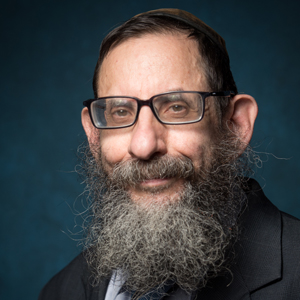 Online, I can access thousands of Torah books. I can read or confirm a citation in thousands of classic works of literature, philosophy and history. Innumerable scholarly journals, once available only in specialized libraries, appear on my screen with the tap of a few keys. On a good day, one feels like a child let loose in a candy store with an unlimited allowance. What can be more democratic? The only unfairness, it seems, is to the valuable work that is not yet easily obtainable and gets lost or is known, if at all, only through random, often misleading paraphrase.
Nevertheless, the exponential increase in printed words poses a problem for democratic, egalitarian readers. What deserves to be read and how carefully should it be read?
Take an example: I am currently studying R. Yisrael Gustman’s Kuntresei Shiurim on the Talmudic tractate Bava Kamma, which deals with the laws of damages. R. Gustman, the youngest rabbinic judge in 1930s’ Vilna, survived the war, and his books are based on the lectures he gave in Jerusalem decades later. His Bava Kamma is over 400 double-columned folio pages. Unless you are blessed with R. Gustman’s erudition and analytic acuity, his work is best read in small doses, a couple of pages at a time, preferably with pauses to consult, as necessary, the Talmudic, medieval and modern authorities he interprets and argues with. Online libraries make it much easier to call up these sources when they are not at hand.
But the real work requires careful reading, not efficient scrolling. Are the volumes of Kuntresei Shiurim online? If so, I’d be grateful to use them for reference but not for intensive study.
Although the Yeshiva University library catalogue lists hundreds of commentaries on Bava Kamma along with much more scholarship devoted to the topic of damages in Jewish law, few advanced Talmudists would criticize my decision to spend countless hours studying R. Gustman. The elite have endorsed the high and probably enduring quality of his contribution; most of the other volumes I could have picked off the shelf have not met that standard. Those lesser authors also labored mightily, and reading them demands serious concentration. Uninitiated, well-meaning internet browsers would not readily distinguish the best from the mediocre. That’s the problem: the more you can get your hands on, the greater the advantage accruing to the readers who are “plugged in,” that is, those who know what of this vast primary and secondary literature is most worth studying and how to study it and when to close the books and do your own hard thinking.
What is true in Talmud is true for other disciplines I am familiar with: philosophy, history, creative literature, criticism and so forth. Therefore, the explosion in printed material may make it even more urgent for readers to be well-informed and selective about what they choose to read. Such discrimination is a function of education and the thoughtful appropriation of informed, sophisticated opinion. The internet cannot be relied on to do this. To the contrary, it may even encourage the illusion that everything out there is equally trustworthy and valuable.
Online, I can access thousands of Torah books. I can read or confirm a citation in thousands of classic works of literature, philosophy and history. Innumerable scholarly journals, once available only in specialized libraries, appear on my screen with the tap of a few keys. On a good day, one feels like a child let loose in a candy store with an unlimited allowance. What can be more democratic? The only unfairness, it seems, is to the valuable work that is not yet easily obtainable and gets lost or is known, if at all, only through random, often misleading paraphrase.
Nevertheless, the exponential increase in printed words poses a problem for democratic, egalitarian readers. What deserves to be read and how carefully should it be read?
Take an example: I am currently studying R. Yisrael Gustman’s Kuntresei Shiurim on the Talmudic tractate Bava Kamma, which deals with the laws of damages. R. Gustman, the youngest rabbinic judge in 1930s’ Vilna, survived the war, and his books are based on the lectures he gave in Jerusalem decades later. His Bava Kamma is over 400 double-columned folio pages. Unless you are blessed with R. Gustman’s erudition and analytic acuity, his work is best read in small doses, a couple of pages at a time, preferably with pauses to consult, as necessary, the Talmudic, medieval and modern authorities he interprets and argues with. Online libraries make it much easier to call up these sources when they are not at hand.
But the real work requires careful reading, not efficient scrolling. Are the volumes of Kuntresei Shiurim online? If so, I’d be grateful to use them for reference but not for intensive study.
Although the Yeshiva University library catalogue lists hundreds of commentaries on Bava Kamma along with much more scholarship devoted to the topic of damages in Jewish law, few advanced Talmudists would criticize my decision to spend countless hours studying R. Gustman. The elite have endorsed the high and probably enduring quality of his contribution; most of the other volumes I could have picked off the shelf have not met that standard. Those lesser authors also labored mightily, and reading them demands serious concentration. Uninitiated, well-meaning internet browsers would not readily distinguish the best from the mediocre. That’s the problem: the more you can get your hands on, the greater the advantage accruing to the readers who are “plugged in,” that is, those who know what of this vast primary and secondary literature is most worth studying and how to study it and when to close the books and do your own hard thinking.
What is true in Talmud is true for other disciplines I am familiar with: philosophy, history, creative literature, criticism and so forth. Therefore, the explosion in printed material may make it even more urgent for readers to be well-informed and selective about what they choose to read. Such discrimination is a function of education and the thoughtful appropriation of informed, sophisticated opinion. The internet cannot be relied on to do this. To the contrary, it may even encourage the illusion that everything out there is equally trustworthy and valuable.
 Writing at midcentury, Marcel Thomas, keeper in the Department of Manuscripts at the Bibliothèque nationale, surmised that “the new media of our age, broadcasting and the cinema, may help us grasp how ideas and works can be transmitted without passing through the medium of print.”(1) Scarcely six decades later, written culture seems even more contingent than Thomas had imagined. The “new media of our age” now includes digital simulations of what we once only experienced as textual objects.
Because reading has almost always presupposed a sensory and tactile relationship to language and written form, it makes sense to ask whether we’ve arrived at a major turning point in the history of the book. Perhaps the digital present has relegated the codex to a mechanical past, just as the introduction of movable type to early modern Europe occasioned a radical shift away from medieval forms of textual production, such as the bound manuscript book, an object encompassing the skilled labor of scribes, artisans, and craftsmen.
Indeed, early studies of the printing press singled out its role in the emergence of modernity. Although scholars now criticize the teleological assumptions behind this argument, the pervasive changes brought about by revolutions in book production and printing technology are undeniable, even if those changes seem abstract from the standpoint of digital culture. One obvious result is of course the very notion that the early modern world was materially distinct from previous historical periods. For some humanists, it was precisely the vicissitudes of medieval manuscript production that made premodern texts and documents appear inauthentic, deceptive, or corrupt. Renaissance philological and historical criticism enabled the recovery of classical learning but also helped expose medieval forgeries, as the Italian humanist Lorenzo Valla famously demonstrated in his systematic deconstruction of the so-called Donation of Constantine, a legal document recording the decision by emperor Constantine to grant the papacy dominion over the western provinces of the Roman empire.
First published in 1506, Valla’s critique of this notorious eighth-century forgery went beyond his immediate concern with the political power of the medieval church. By complicating the assumption that Constantine’s reign had been “a crucial turning point in history,” to quote Robert Black, Valla also framed his own era as a legitimate instance of cultural change, different if no less significant in its long-range potential; this is perhaps most evident in his focus on the material contingencies of manuscripts, and the authority naively ascribed to them by medieval audiences.(2) Citing Josephus, he recounts the story of Jobal, the inventor of music who emblazoned his teachings on twin columns, one brick and the other stone, impervious to all change and decay. “Did Constantine really sign a donation of the world only on papyrus and with ink?” Valla asks incredulously.(3)
In fact, rather than a radical break from the past, the fifteenth century, when Valla flourished, was an era in which it was difficult to imagine the printed book without reference to its antecedent material forms. Many early printed books were fashioned to resemble manuscripts, employing typefaces that meticulously approximated handwritten script; or leaving select letters, such as initial capitals, to be ornamented by hand at a later stage of the production process; or even occasionally using vellum rather than paper (see, for example, the Gutenberg Bible on display at the Pierpont Morgan Library, in midtown). In some cases, especially in reformist circles, printed documents were copied by hand and transmitted in manuscript form, only to be converted at a later point back into print; many works circulated in both forms simultaneously, and in roughly equal numbers. Nor was manuscript culture entirely removed from the standardized production methods typical of the print era; the rise of guilds in late medieval urban areas meant that professional scribes and illustrators could readily collaborate in meeting customer demand. The boundaries between historically specific technologies of writing and material form are not so easily discerned as our models for periodization sometimes assume—even less so, perhaps, from a modern vantage point that exalts technological innovation as the driving force of all social and cultural change.
Likewise, medieval ideas about the materiality of books and writing have profoundly shaped how we comprehend the digital present. Premodern epistemologies of the written artifact supply concepts such as “searching,” “copying,” and “pasting,” all of which evoke the immersive experience of codex literacy, along with the material supplements authors and scribes devised to aid readers in navigating large or densely scripted volumes (e.g., paste-ins and other visual or textual cues). These terms link modern reading practices to much earlier notions of matter, form, and substance.
This is not the first time in history, then, that the future of the book seems predicated on the eclipse of its material precursors. But however disjunctive such changes may feel to those whose literacy was shaped under different circumstances, and to whatever degree all this might warrant thinking in terms of decisive historical “turning points,” it’s worth remembering that our dominant systems of representation and knowledge inhere in the concepts, terms, and categories of written culture—which, for the time being at least, still means the book.
1) L. Febvre and H.-J. Martin, The Coming of the Book, trans. D. Gerard, ed. G. Nowell-Smith, D. Wootton (London, 1976), 23.
2) L. Valla, On the Donation of Constantine, ed. G. W. Bowerstock (Cambridge, Mass., 2008), vii.
3) Valla, Donation, 32.
Writing at midcentury, Marcel Thomas, keeper in the Department of Manuscripts at the Bibliothèque nationale, surmised that “the new media of our age, broadcasting and the cinema, may help us grasp how ideas and works can be transmitted without passing through the medium of print.”(1) Scarcely six decades later, written culture seems even more contingent than Thomas had imagined. The “new media of our age” now includes digital simulations of what we once only experienced as textual objects.
Because reading has almost always presupposed a sensory and tactile relationship to language and written form, it makes sense to ask whether we’ve arrived at a major turning point in the history of the book. Perhaps the digital present has relegated the codex to a mechanical past, just as the introduction of movable type to early modern Europe occasioned a radical shift away from medieval forms of textual production, such as the bound manuscript book, an object encompassing the skilled labor of scribes, artisans, and craftsmen.
Indeed, early studies of the printing press singled out its role in the emergence of modernity. Although scholars now criticize the teleological assumptions behind this argument, the pervasive changes brought about by revolutions in book production and printing technology are undeniable, even if those changes seem abstract from the standpoint of digital culture. One obvious result is of course the very notion that the early modern world was materially distinct from previous historical periods. For some humanists, it was precisely the vicissitudes of medieval manuscript production that made premodern texts and documents appear inauthentic, deceptive, or corrupt. Renaissance philological and historical criticism enabled the recovery of classical learning but also helped expose medieval forgeries, as the Italian humanist Lorenzo Valla famously demonstrated in his systematic deconstruction of the so-called Donation of Constantine, a legal document recording the decision by emperor Constantine to grant the papacy dominion over the western provinces of the Roman empire.
First published in 1506, Valla’s critique of this notorious eighth-century forgery went beyond his immediate concern with the political power of the medieval church. By complicating the assumption that Constantine’s reign had been “a crucial turning point in history,” to quote Robert Black, Valla also framed his own era as a legitimate instance of cultural change, different if no less significant in its long-range potential; this is perhaps most evident in his focus on the material contingencies of manuscripts, and the authority naively ascribed to them by medieval audiences.(2) Citing Josephus, he recounts the story of Jobal, the inventor of music who emblazoned his teachings on twin columns, one brick and the other stone, impervious to all change and decay. “Did Constantine really sign a donation of the world only on papyrus and with ink?” Valla asks incredulously.(3)
In fact, rather than a radical break from the past, the fifteenth century, when Valla flourished, was an era in which it was difficult to imagine the printed book without reference to its antecedent material forms. Many early printed books were fashioned to resemble manuscripts, employing typefaces that meticulously approximated handwritten script; or leaving select letters, such as initial capitals, to be ornamented by hand at a later stage of the production process; or even occasionally using vellum rather than paper (see, for example, the Gutenberg Bible on display at the Pierpont Morgan Library, in midtown). In some cases, especially in reformist circles, printed documents were copied by hand and transmitted in manuscript form, only to be converted at a later point back into print; many works circulated in both forms simultaneously, and in roughly equal numbers. Nor was manuscript culture entirely removed from the standardized production methods typical of the print era; the rise of guilds in late medieval urban areas meant that professional scribes and illustrators could readily collaborate in meeting customer demand. The boundaries between historically specific technologies of writing and material form are not so easily discerned as our models for periodization sometimes assume—even less so, perhaps, from a modern vantage point that exalts technological innovation as the driving force of all social and cultural change.
Likewise, medieval ideas about the materiality of books and writing have profoundly shaped how we comprehend the digital present. Premodern epistemologies of the written artifact supply concepts such as “searching,” “copying,” and “pasting,” all of which evoke the immersive experience of codex literacy, along with the material supplements authors and scribes devised to aid readers in navigating large or densely scripted volumes (e.g., paste-ins and other visual or textual cues). These terms link modern reading practices to much earlier notions of matter, form, and substance.
This is not the first time in history, then, that the future of the book seems predicated on the eclipse of its material precursors. But however disjunctive such changes may feel to those whose literacy was shaped under different circumstances, and to whatever degree all this might warrant thinking in terms of decisive historical “turning points,” it’s worth remembering that our dominant systems of representation and knowledge inhere in the concepts, terms, and categories of written culture—which, for the time being at least, still means the book.
1) L. Febvre and H.-J. Martin, The Coming of the Book, trans. D. Gerard, ed. G. Nowell-Smith, D. Wootton (London, 1976), 23.
2) L. Valla, On the Donation of Constantine, ed. G. W. Bowerstock (Cambridge, Mass., 2008), vii.
3) Valla, Donation, 32.
 Predictions of the book’s imminent death are nothing new. From the advent of mass circulation daily newspapers in the 19th century to the spread of movies, radio and television in the 20th, the prophets of cultural doom have repeatedly declared the book to be an endangered species. And yet it survived. Is there any reason to think that this time will be different?
As a historian, I study the past. Divining the future is an activity I’m happy to leave to astrologers, palm-readers and “futurologists” at the Rand Corporation. But while history may not be able to tell us what will happen, it can provide some guidance in identifying the crucial issues to watch. Based on my own work in the field of book history, I would suggest that the real question today is not whether the book will survive but what forms it will assume.
The mutability of the book’s form has been a recurrent theme in its history. The technical term for the book as most people know it today (a book consisting of individual pages as opposed to a scroll) is the “codex.” Generally associated with the spread of Christianity in the Roman empire, the codex gradually supplanted the scroll in the period of late antiquity and achieved near total dominance in the medieval Christian West (though not of course among Jews, who retained their Torah scrolls).
When, in the mid-15th century, Johannes Gutenberg invented the art of printing with movable type, he reproduced an already-existing form of the book—reproduced it so closely, in fact, that to the untrained eye, an early printed book can seem practically indistinguishable from a late-medieval handwritten codex. Nearly everything about the famous Gutenberg Bible—from the typeface in which it is printed, to the disposition of words on the page, to the red-lettering and the decorative flourishes added by hand after the printing—invites comparisons with the finest manuscript Bibles of the same period. Such close reliance on an inherited model was characteristic of the transitional period when print was establishing itself.
Little by little, however, the printed book broke free of its attachment to earlier models. It shed its hand-drawn elements and became purely typographical; it acquired pagination, title pages and tables of contents; its typefaces no longer resembled scribal hands; and a whole new architecture of the printed page, featuring indented paragraphs and chapter breaks, made its appearance.
Today, I would argue, we are still in a transitional phase. Texts are migrating from paper to screen, but like Gutenberg’s Bible more than half a millennium ago, e-books remain wedded to an inherited form. They continue to be broken up into discrete pages; in fact, they are designed to foster the illusion of “turning” pages. The Kindle with its leather (or imitation leather) cover looks from the outside like a slender codex. And to my knowledge, e-books have not incorporated the multimedia features that one might have expected, at least not standard trade books.
Textbooks, however, seem to fall in a different category. Some of them have indeed begun to combine alphabetic text with audio and video. It is too soon to say whether such e-textbooks are in the vanguard of historical change. But one thing is fairly certain: while the book will survive, its form will mutate.
Jeffrey Freedman has published extensively in the field of book and media history and teaches classes at Stern and Yeshiva Colleges on “Media Revolutions: From Scroll to Screen” and “History of the Book: From Gutenberg to Google.” He would like to thank his students for their input on questions pertaining to the future of the book.
Predictions of the book’s imminent death are nothing new. From the advent of mass circulation daily newspapers in the 19th century to the spread of movies, radio and television in the 20th, the prophets of cultural doom have repeatedly declared the book to be an endangered species. And yet it survived. Is there any reason to think that this time will be different?
As a historian, I study the past. Divining the future is an activity I’m happy to leave to astrologers, palm-readers and “futurologists” at the Rand Corporation. But while history may not be able to tell us what will happen, it can provide some guidance in identifying the crucial issues to watch. Based on my own work in the field of book history, I would suggest that the real question today is not whether the book will survive but what forms it will assume.
The mutability of the book’s form has been a recurrent theme in its history. The technical term for the book as most people know it today (a book consisting of individual pages as opposed to a scroll) is the “codex.” Generally associated with the spread of Christianity in the Roman empire, the codex gradually supplanted the scroll in the period of late antiquity and achieved near total dominance in the medieval Christian West (though not of course among Jews, who retained their Torah scrolls).
When, in the mid-15th century, Johannes Gutenberg invented the art of printing with movable type, he reproduced an already-existing form of the book—reproduced it so closely, in fact, that to the untrained eye, an early printed book can seem practically indistinguishable from a late-medieval handwritten codex. Nearly everything about the famous Gutenberg Bible—from the typeface in which it is printed, to the disposition of words on the page, to the red-lettering and the decorative flourishes added by hand after the printing—invites comparisons with the finest manuscript Bibles of the same period. Such close reliance on an inherited model was characteristic of the transitional period when print was establishing itself.
Little by little, however, the printed book broke free of its attachment to earlier models. It shed its hand-drawn elements and became purely typographical; it acquired pagination, title pages and tables of contents; its typefaces no longer resembled scribal hands; and a whole new architecture of the printed page, featuring indented paragraphs and chapter breaks, made its appearance.
Today, I would argue, we are still in a transitional phase. Texts are migrating from paper to screen, but like Gutenberg’s Bible more than half a millennium ago, e-books remain wedded to an inherited form. They continue to be broken up into discrete pages; in fact, they are designed to foster the illusion of “turning” pages. The Kindle with its leather (or imitation leather) cover looks from the outside like a slender codex. And to my knowledge, e-books have not incorporated the multimedia features that one might have expected, at least not standard trade books.
Textbooks, however, seem to fall in a different category. Some of them have indeed begun to combine alphabetic text with audio and video. It is too soon to say whether such e-textbooks are in the vanguard of historical change. But one thing is fairly certain: while the book will survive, its form will mutate.
Jeffrey Freedman has published extensively in the field of book and media history and teaches classes at Stern and Yeshiva Colleges on “Media Revolutions: From Scroll to Screen” and “History of the Book: From Gutenberg to Google.” He would like to thank his students for their input on questions pertaining to the future of the book.
 In order to answer this question, one first needs to understand what value a book brings to its readers.
In marketing, we differentiate between a product’s features and the value or benefits derived from these features. For example, there is an old saying attributed to Revlon: “In the factory, we manufacture cosmetics. At the beauty counter, we sell hope.” Whoever said this knew that customers do not buy features (cosmetic ingredients); they buy benefits (hope). These benefits help users accomplish their ultimate goals and realize certain values or end states.
What might those values or end states be when it comes to a book, and what then is different or similar between the physical existence of the written word versus its virtual twins, the audio book or e-book?
Obviously, both kinds provide information about or a glimpse into an imaginative far-away world since the written or spoken word is the same regardless of its format. What is missing, though, is how our senses experience these words or, more specifically, the vessel in which it is delivered to us. In my research on affect and feelings, I found that the feelings derived from a product are crucial to the evaluation, price and consumption of that product. Can the way a story is consumed influence the reading experience?
The benefits derived from an audio book or an e-book are clear and mostly functional, as they serve the purpose of efficiency: easy to carry (many books inserted into one device), easy to read or listen to (font size is adjustable, screen is illuminated, ear pods are wireless), easy to care for and are immediate (download in a click of a button). The physical book requires a trip to the store or a wait online for delivery, it demands its own personal space and it needs to be cared for and protected. These exact features that make it less efficient are also the ones that make it more lovable and cherished.
The fact that a book is physically there for us and needs our attention, that we can cuddle it in our hands, feel it and bend it are exactly the reasons people feel good about reading a book. It occupies not just one of our senses (hearing in the case of an audio book or vision in an e-book), it occupies our sense of vision, our sense of touch, our sense of hearing (the rustle of the pages) and our sense of smell. By activating these other senses simultaneously, the physical book brings value to the reader that can never be brought on by an audio book or e-book; it evokes our emotional system and through that allows us to experience the story on a higher emotional level.
Going back to the original question, then, the physical book will always be a part of human lives as long as part of being human is to feel and experience emotions.
In order to answer this question, one first needs to understand what value a book brings to its readers.
In marketing, we differentiate between a product’s features and the value or benefits derived from these features. For example, there is an old saying attributed to Revlon: “In the factory, we manufacture cosmetics. At the beauty counter, we sell hope.” Whoever said this knew that customers do not buy features (cosmetic ingredients); they buy benefits (hope). These benefits help users accomplish their ultimate goals and realize certain values or end states.
What might those values or end states be when it comes to a book, and what then is different or similar between the physical existence of the written word versus its virtual twins, the audio book or e-book?
Obviously, both kinds provide information about or a glimpse into an imaginative far-away world since the written or spoken word is the same regardless of its format. What is missing, though, is how our senses experience these words or, more specifically, the vessel in which it is delivered to us. In my research on affect and feelings, I found that the feelings derived from a product are crucial to the evaluation, price and consumption of that product. Can the way a story is consumed influence the reading experience?
The benefits derived from an audio book or an e-book are clear and mostly functional, as they serve the purpose of efficiency: easy to carry (many books inserted into one device), easy to read or listen to (font size is adjustable, screen is illuminated, ear pods are wireless), easy to care for and are immediate (download in a click of a button). The physical book requires a trip to the store or a wait online for delivery, it demands its own personal space and it needs to be cared for and protected. These exact features that make it less efficient are also the ones that make it more lovable and cherished.
The fact that a book is physically there for us and needs our attention, that we can cuddle it in our hands, feel it and bend it are exactly the reasons people feel good about reading a book. It occupies not just one of our senses (hearing in the case of an audio book or vision in an e-book), it occupies our sense of vision, our sense of touch, our sense of hearing (the rustle of the pages) and our sense of smell. By activating these other senses simultaneously, the physical book brings value to the reader that can never be brought on by an audio book or e-book; it evokes our emotional system and through that allows us to experience the story on a higher emotional level.
Going back to the original question, then, the physical book will always be a part of human lives as long as part of being human is to feel and experience emotions.
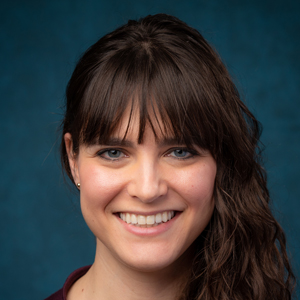 We think a lot about how to communicate positive values to our children. We model good behaviors. We reward prosocial actions. We read stories based around positive morals. The list goes on.
All of this is to say that we try to cram as much moral content into our children’s lives as we can. Of course, this is a good thing: how else can we raise good people, aside from communicating the right values to them?
However, talking about values is not the whole story. We spend a huge amount of time thinking about the content of what we say and read to our children, but we often overlook the fact that the very structure of our language, independent of content, makes a difference.
When it comes to teaching values, we constantly focus on identities (“you’re a good helper”) rather than behaviors (“you’re good at helping”). At first glance, this doesn’t sound like a big difference or a bad thing: shouldn’t we encourage our children to be among the world’s helpers? Sure. But problems arise when we consider what children do in the face of setbacks.
Setbacks are a normal and inevitable part of childhood. Maybe you’re trying to help Dad set the table for dinner, but you accidentally drop a bowl and break it. Maybe you’re trying to give your baby sister a hug, but you squeeze too hard and she starts to cry. Every well-meaning child, at some point, encounters a situation where he or she accidentally does harm rather than good, despite the best of intentions.
At times like this, if you think that being moral is all about the identity you’ve established (i.e., as a helper or a non-helper), then once you encounter a setback, you’ve run the risk of pushing your identity to the wrong side. As a result, you might be less motivated to attempt those prosocial behaviors again in the future.
A new set of studies, published in the journal Child Development by Emily Foster Hanson and her colleagues at New York University, supports this idea. In these studies, 4- and 5-year-old children were told a story in which they could “be a helper” or they could simply “help.” Then, they played a game where they were given an opportunity to help someone, but the researchers had rigged the game so that all the children would fail. After this failure, children were presented with opportunities to perform additional helpful behaviors. Would the type of language that children heard at the beginning of the study influence how likely they were to engage in helpful behaviors at the end?
The answer is yes. Children who had heard the story about “helping” were far more likely to attempt additional helpful behaviors after a setback than children who had heard the story about “being a helper.” Talking to children about adopting the identity of a helper seemed to diminish their future motivation, whereas describing helping as a behavior they could perform didn’t.
If we want to incorporate these ideas into the books that we read to our children, we should start thinking beyond content. We should think more about how the language we use might influence children in ways we don’t even realize. Encouraging a value-based identity, like being a helper, feels good because it encourages children to join the ranks. In the face of setbacks, however, this strategy can backfire. A more useful approach may be to teach children that there are good behaviors and bad behaviors and that they can rack up moral points by simply trying to perform as many good behaviors as they can, regardless of whether they are always successful.
We think a lot about how to communicate positive values to our children. We model good behaviors. We reward prosocial actions. We read stories based around positive morals. The list goes on.
All of this is to say that we try to cram as much moral content into our children’s lives as we can. Of course, this is a good thing: how else can we raise good people, aside from communicating the right values to them?
However, talking about values is not the whole story. We spend a huge amount of time thinking about the content of what we say and read to our children, but we often overlook the fact that the very structure of our language, independent of content, makes a difference.
When it comes to teaching values, we constantly focus on identities (“you’re a good helper”) rather than behaviors (“you’re good at helping”). At first glance, this doesn’t sound like a big difference or a bad thing: shouldn’t we encourage our children to be among the world’s helpers? Sure. But problems arise when we consider what children do in the face of setbacks.
Setbacks are a normal and inevitable part of childhood. Maybe you’re trying to help Dad set the table for dinner, but you accidentally drop a bowl and break it. Maybe you’re trying to give your baby sister a hug, but you squeeze too hard and she starts to cry. Every well-meaning child, at some point, encounters a situation where he or she accidentally does harm rather than good, despite the best of intentions.
At times like this, if you think that being moral is all about the identity you’ve established (i.e., as a helper or a non-helper), then once you encounter a setback, you’ve run the risk of pushing your identity to the wrong side. As a result, you might be less motivated to attempt those prosocial behaviors again in the future.
A new set of studies, published in the journal Child Development by Emily Foster Hanson and her colleagues at New York University, supports this idea. In these studies, 4- and 5-year-old children were told a story in which they could “be a helper” or they could simply “help.” Then, they played a game where they were given an opportunity to help someone, but the researchers had rigged the game so that all the children would fail. After this failure, children were presented with opportunities to perform additional helpful behaviors. Would the type of language that children heard at the beginning of the study influence how likely they were to engage in helpful behaviors at the end?
The answer is yes. Children who had heard the story about “helping” were far more likely to attempt additional helpful behaviors after a setback than children who had heard the story about “being a helper.” Talking to children about adopting the identity of a helper seemed to diminish their future motivation, whereas describing helping as a behavior they could perform didn’t.
If we want to incorporate these ideas into the books that we read to our children, we should start thinking beyond content. We should think more about how the language we use might influence children in ways we don’t even realize. Encouraging a value-based identity, like being a helper, feels good because it encourages children to join the ranks. In the face of setbacks, however, this strategy can backfire. A more useful approach may be to teach children that there are good behaviors and bad behaviors and that they can rack up moral points by simply trying to perform as many good behaviors as they can, regardless of whether they are always successful.
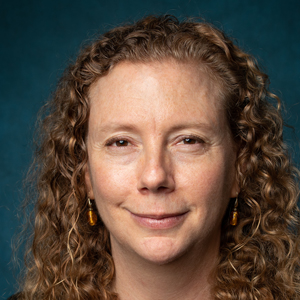 When I think of the future of the book, I think of the past of the book. In particular, I think of one special book: The Backwash of War, by Ellen N. La Motte. I have been immersed in researching and writing about this “lost” classic and its “lost” author for the past few years.
In this remarkable collection of interrelated stories, La Motte, an American volunteer nurse who worked in a French field hospital during World War I, offers a profoundly disturbing image of war. Midway through the book, she explains, “Well, there are many people to write you of the noble side, the heroic side, the exalted side of war. I must write you of what I have seen, the other side, the backwash.”
Published in the fall of 1916, The Backwash of War was immediately banned in England and France. Two years later, after being widely hailed as America’s most significant work of war writing and going through four printings, the book was deemed damaging to morale and censored in wartime America. Except for an unsuccessful re-release in 1919 and a reissued edition in 1934, the book—once called “immortal”—remained out of print for nearly a century.
When I think of the future of the book, I think of the past of the book. In particular, I think of one special book: The Backwash of War, by Ellen N. La Motte. I have been immersed in researching and writing about this “lost” classic and its “lost” author for the past few years.
In this remarkable collection of interrelated stories, La Motte, an American volunteer nurse who worked in a French field hospital during World War I, offers a profoundly disturbing image of war. Midway through the book, she explains, “Well, there are many people to write you of the noble side, the heroic side, the exalted side of war. I must write you of what I have seen, the other side, the backwash.”
Published in the fall of 1916, The Backwash of War was immediately banned in England and France. Two years later, after being widely hailed as America’s most significant work of war writing and going through four printings, the book was deemed damaging to morale and censored in wartime America. Except for an unsuccessful re-release in 1919 and a reissued edition in 1934, the book—once called “immortal”—remained out of print for nearly a century.
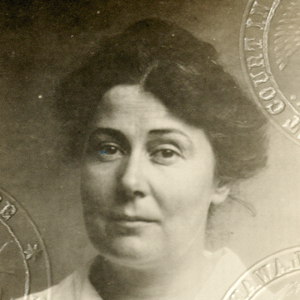 Ellen La Motte
Ellen La Motte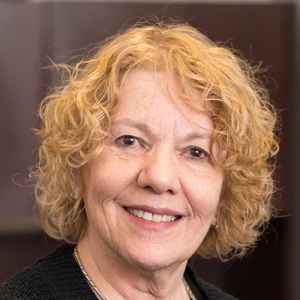 Holocaust literature will continue to serve as a central repository of trauma and memory for the generations who seek to learn the essentials of the Shoah. Narratives, poetry and testimonial literature offer the power and poignancy of a story of an individual, central to knowing that person.
Reading such literature will bring us as close as we can come to uncovering what survivors, whom we will no longer know, wanted us to comprehend.
Some literature offers additional clues, traces of lost lives that can guide readers to a richer, deeper understanding of survivors’ experiences and feelings. These traces include a focus on the remnants of an era, the belongings that mattered to the Jews. Such artifacts can illustrate a particular moment, illuminate an individual story and elucidate a specific detail of a broad historical narrative. Future study, which must seek to make this receding history both tangible and personal if it is to remain relevant, will embrace the literature that describes artifacts and their fates, because such accounts tell us something about the Jews’ ways of responding to the tragedy engulfing them when they themselves cannot.
As well, learning about such artifacts in the context of how Jews were trying to survive prompts essential questions that must arise from literature study and will encourage further scholarship, a goal more crucial as the event recedes. Using the tools of historical knowing—the habits of mind and the methods of questioning and close reading that guide scholars of literature as well as historians—we will be able to find in literary narrative the uses, meanings and fates of particular artifacts that would otherwise be lost to us, and, in so doing, find remnants of the people lost to us as well.
In this brief essay, one example must suffice. We can learn more about ghettoization, for instance, from literature about possessions that the Jews took with them when they were forced from their homes: what they thought was most useful and valuable; the torment they faced as the Nazis forced them into ever-smaller quarters, which dictated what belongings they could bring; the manner in which families moved their meager possessions from place to place; and what happened to the things they left behind. Literature offers several such chronicles that will become imperative in a future canon. Here is just one.
Wladyslaw Szlengel, whom Emanuel Ringelblum called “the poet of the ghetto” (Kassow, 2009, p. 316), wrote about the “Things” (“Rzeczy”) the Jews carried as they left their homes on “three of Warsaw’s best streets” (p. 316), forced into lesser but still serviceable quarters:
Holocaust literature will continue to serve as a central repository of trauma and memory for the generations who seek to learn the essentials of the Shoah. Narratives, poetry and testimonial literature offer the power and poignancy of a story of an individual, central to knowing that person.
Reading such literature will bring us as close as we can come to uncovering what survivors, whom we will no longer know, wanted us to comprehend.
Some literature offers additional clues, traces of lost lives that can guide readers to a richer, deeper understanding of survivors’ experiences and feelings. These traces include a focus on the remnants of an era, the belongings that mattered to the Jews. Such artifacts can illustrate a particular moment, illuminate an individual story and elucidate a specific detail of a broad historical narrative. Future study, which must seek to make this receding history both tangible and personal if it is to remain relevant, will embrace the literature that describes artifacts and their fates, because such accounts tell us something about the Jews’ ways of responding to the tragedy engulfing them when they themselves cannot.
As well, learning about such artifacts in the context of how Jews were trying to survive prompts essential questions that must arise from literature study and will encourage further scholarship, a goal more crucial as the event recedes. Using the tools of historical knowing—the habits of mind and the methods of questioning and close reading that guide scholars of literature as well as historians—we will be able to find in literary narrative the uses, meanings and fates of particular artifacts that would otherwise be lost to us, and, in so doing, find remnants of the people lost to us as well.
In this brief essay, one example must suffice. We can learn more about ghettoization, for instance, from literature about possessions that the Jews took with them when they were forced from their homes: what they thought was most useful and valuable; the torment they faced as the Nazis forced them into ever-smaller quarters, which dictated what belongings they could bring; the manner in which families moved their meager possessions from place to place; and what happened to the things they left behind. Literature offers several such chronicles that will become imperative in a future canon. Here is just one.
Wladyslaw Szlengel, whom Emanuel Ringelblum called “the poet of the ghetto” (Kassow, 2009, p. 316), wrote about the “Things” (“Rzeczy”) the Jews carried as they left their homes on “three of Warsaw’s best streets” (p. 316), forced into lesser but still serviceable quarters:
 At an annual conference for academic librarians at Rutgers University, James G. Neal, then Vice President for Information Services and University Librarian at Columbia University, spoke on “The Imperfect Storm: The Prospects for Systemic Change Across Academic Libraries.” (1)
Scandalizing his audience, he began by diagnosing us as suffering from a continual state of anxiety about the future and our organizations as in crisis. The stimuli for these observations, of course, were the cosmic changes the digital universe has brought to the place of libraries in the academic enterprise.
Neal’s prospects for changing library roles included libraries as consumers, aggregators, publishers, educators, R&D organizations, entrepreneurs and policy advocates. (2)
Consumers? Yes, academic librarians are increasingly “educated consumers,” adopting creative methods for negotiating consortial agreements with commercial distributors.
Publishers? Yes, we have launched institutional repositories as an alternative channel for highlighting and disseminating faculty scholarly and creative work.
Educators? Certainly, we collaborate with faculty members in providing instruction in research methods so as to cultivate discerning information-seeking skills in students.
Entrepreneurs? Indeed, adopting an entrepreneurial approach to change is essential for any successful organization, and successful organizations adapt their core competencies to support innovation. (3)
But organizational agility is fraught with ambiguity, and curating materials for teaching, learning, research, and inspiration in the digital age is still more intuitive than data-driven. As digital formats replicate or supersede print publications, we need a better understanding of the cognitive aspects of reading text on the screen in comparison with text on a page. Researchers at the University of Maryland concluded that students are less likely to comprehend and retain complex material read on a screen than on the printed page. (4)
Nevertheless, several academic libraries have jettisoned their print collections. In 2010, Cushing Academy, a small boarding school in Massachusetts, instituted a digital-only library. (5) And in preparation for a major building renovation, Atlanta’s esteemed Georgia Tech has relocated almost all its books to a warehouse five miles from campus, reflecting a paradigm shift that favors digital learning and scholarship. Critics, however, observe that the change eclipses the intellectual serendipity that browsing affords.
Although not universal, these innovations have profound implications for the role of the library in the academic enterprise, and the Association of College and Research Libraries (ACRL) presupposes this in its recently ratified set of guidelines. (6) Rather than mandate policies and procedures, ACRL suggests a set of performance indicators, from institutional effectiveness to external relations, and advocates an evidence-based approach that aligns with the overarching expectations that accrediting agencies use to assess parent institutions.
Since academic library buildings may be campus centerpieces, what happens to them if their function as information warehouses diminishes? What is the library building of the future? With as little as 15 percent of space devoted to collections, library space allocation models are radically different than they were only 20 years ago. (7) The most successful models view the library building as an academic town square, as a place for student engagement, collaboration and peer-to-peer learning.
If, as John Minogue maintains, the 20th-century university is obsolete, is its library endangered, too? (8)
It is increasingly clear that a student-centered facility and dynamic set of services is the key to a vital and evolving academic library. Is there a mantra—a guiding principle—to help those of us entrusted with reinventing these citadels of learning? Clearly, that mantra, which comes from Lorcan Dempsey, vice president and chief strategist of the Online Computer Library Center, is that the old model of the “user in the life of the library” is now the “library in the life of the user.” (9)
1) VALE New Jersey. (2011). Strengthening connections: Keeping our libraries vital [Brochure]. Wayne, NJ: VALE New Jersey. Twelfth Annual VALE/NJ ACRL/NJLA CUS Users' Conference.
2) Neal, J. G. (2011). The imperfect storm: The prospects for systemic change across academic libraries [PowerPoint slides]. Retrieved from
At an annual conference for academic librarians at Rutgers University, James G. Neal, then Vice President for Information Services and University Librarian at Columbia University, spoke on “The Imperfect Storm: The Prospects for Systemic Change Across Academic Libraries.” (1)
Scandalizing his audience, he began by diagnosing us as suffering from a continual state of anxiety about the future and our organizations as in crisis. The stimuli for these observations, of course, were the cosmic changes the digital universe has brought to the place of libraries in the academic enterprise.
Neal’s prospects for changing library roles included libraries as consumers, aggregators, publishers, educators, R&D organizations, entrepreneurs and policy advocates. (2)
Consumers? Yes, academic librarians are increasingly “educated consumers,” adopting creative methods for negotiating consortial agreements with commercial distributors.
Publishers? Yes, we have launched institutional repositories as an alternative channel for highlighting and disseminating faculty scholarly and creative work.
Educators? Certainly, we collaborate with faculty members in providing instruction in research methods so as to cultivate discerning information-seeking skills in students.
Entrepreneurs? Indeed, adopting an entrepreneurial approach to change is essential for any successful organization, and successful organizations adapt their core competencies to support innovation. (3)
But organizational agility is fraught with ambiguity, and curating materials for teaching, learning, research, and inspiration in the digital age is still more intuitive than data-driven. As digital formats replicate or supersede print publications, we need a better understanding of the cognitive aspects of reading text on the screen in comparison with text on a page. Researchers at the University of Maryland concluded that students are less likely to comprehend and retain complex material read on a screen than on the printed page. (4)
Nevertheless, several academic libraries have jettisoned their print collections. In 2010, Cushing Academy, a small boarding school in Massachusetts, instituted a digital-only library. (5) And in preparation for a major building renovation, Atlanta’s esteemed Georgia Tech has relocated almost all its books to a warehouse five miles from campus, reflecting a paradigm shift that favors digital learning and scholarship. Critics, however, observe that the change eclipses the intellectual serendipity that browsing affords.
Although not universal, these innovations have profound implications for the role of the library in the academic enterprise, and the Association of College and Research Libraries (ACRL) presupposes this in its recently ratified set of guidelines. (6) Rather than mandate policies and procedures, ACRL suggests a set of performance indicators, from institutional effectiveness to external relations, and advocates an evidence-based approach that aligns with the overarching expectations that accrediting agencies use to assess parent institutions.
Since academic library buildings may be campus centerpieces, what happens to them if their function as information warehouses diminishes? What is the library building of the future? With as little as 15 percent of space devoted to collections, library space allocation models are radically different than they were only 20 years ago. (7) The most successful models view the library building as an academic town square, as a place for student engagement, collaboration and peer-to-peer learning.
If, as John Minogue maintains, the 20th-century university is obsolete, is its library endangered, too? (8)
It is increasingly clear that a student-centered facility and dynamic set of services is the key to a vital and evolving academic library. Is there a mantra—a guiding principle—to help those of us entrusted with reinventing these citadels of learning? Clearly, that mantra, which comes from Lorcan Dempsey, vice president and chief strategist of the Online Computer Library Center, is that the old model of the “user in the life of the library” is now the “library in the life of the user.” (9)
1) VALE New Jersey. (2011). Strengthening connections: Keeping our libraries vital [Brochure]. Wayne, NJ: VALE New Jersey. Twelfth Annual VALE/NJ ACRL/NJLA CUS Users' Conference.
2) Neal, J. G. (2011). The imperfect storm: The prospects for systemic change across academic libraries [PowerPoint slides]. Retrieved from